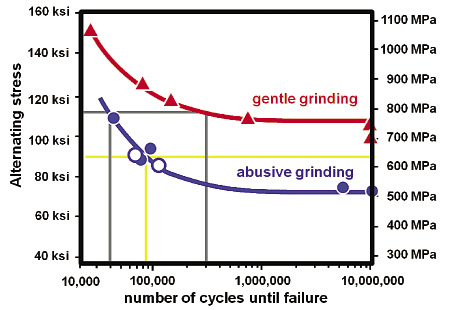Dear Doc: I just got a report that our pistons are experiencing premature fatigue failure, and some people say grinding is the culprit. Is this possible? The parts are fine going out the door, but crack after 5 weeks in service.
The Doc Replies: Grinding certainly could be a culprit. Depending on the material, if the grinding temperature rises above, say, 400° C (752° F), a hardened-steel piston begins to experience residual tensile stresses. These stresses increase with higher grinding temperatures. The stresses don’t necessarily cause cracking, but they weaken the steel. When that “stressed” material is under fatigue loading, failure occurs after fewer cycles.
If grinding temperature rises even higher, say, to 750° to 850° C (1,382° to 1,562° F), depending on the steel, a phase change in the crystal structure of the steel can occur. This new phase is hard and brittle and a killer in terms of fatigue life.
Figure 1 shows a graph based on work done by researchers Michael Field and John Kahles in 1971 about how abusive, high-temperature grinding conditions negatively impact fatigue part life in 51- HRC 4340 steel.
For example, let’s say the shaft was designed considering a stress of 115 ksi (115,000 psi). That will provide 300,000 cycles until the part cracks under fatigue loading (gray lines in figure). But if you grind the part abusively, inducing high residual tensile stresses, part life drops by a factor of 10, to 30,000 cycles.

Figure 1. This graph is based on work done by researchers Michael Field and John Kahles about how abusive, high-temperature grinding conditions negatively impact fatigue part life in 51-HRC 4340 steel.
Let’s say the part designer uses a stress of 100 ksi (yellow lines). That means the part should last pretty much forever without failing. But if the part is ground abusively, it’s only going to last around 90,000 cycles.
I’ve worked with several customers coping with grinding-induced, fatigue-related failure. The solution is always the same: Reduce the grinding temperatures. Once they do this, fatigue life returns to normal.
Dear Doc:I’m using Barkhausen noise analysis to assess burn. After dressing, the signal is low, then gradually increases as the wheel dulls. But if I don’t dress the wheel, it drops again. Is this wheel self-sharpening?
The Doc Replies: That drop is not due to self-sharpening. The Barkhausen signal increases with increasing residual tensile stress, which increases as the grinding temperature rises. However, once you get to the austenitizing temperature, around 750° to 850° C, things get tricky. At this temperature there’s a phase change in the material and the Barkhausen signal drops with this new phase.
Because the Barkhausen magnetization and signal measured by the probe represents an average over some depth into the workpiece, the signal gets “corrupted.” This is because the signal is a mixture of the low response from the austenitized material at the surface and a high response from the stressed material below the surface. You will want to dress the wheel long before this drop occurs. CTE
About the Author: Dr. Jeffrey Badger is an independent grinding consultant. His Web site is www.TheGrindingDoc.com. He’ll be giving his High Intensity Grinding Course March 5-7 in Columbus, Ohio, hosted by Diamond Innovations, and April 28-30 in Latrobe, Pa., hosted by Rush Machinery Inc.Related Glossary Terms
- austenitizing
austenitizing
Heating an alloy above its transformation temperature and then quenching it in a salt bath or other medium that extracts the heat at a sufficiently high rate to prevent formation of undesirable high-temperature-transformation qualities on its surface or in its microstructure. See austenite; martensite; martensiting.
- dressing
dressing
Removal of undesirable materials from “loaded” grinding wheels using a single- or multi-point diamond or other tool. The process also exposes unused, sharp abrasive points. See loading; truing.
- fatigue
fatigue
Phenomenon leading to fracture under repeated or fluctuating stresses having a maximum value less than the tensile strength of the material. Fatigue fractures are progressive, beginning as minute cracks that grow under the action of the fluctuating stress.
- fatigue life
fatigue life
Number of cycles of stress that can be sustained prior to failure under a stated test condition.
- grinding
grinding
Machining operation in which material is removed from the workpiece by a powered abrasive wheel, stone, belt, paste, sheet, compound, slurry, etc. Takes various forms: surface grinding (creates flat and/or squared surfaces); cylindrical grinding (for external cylindrical and tapered shapes, fillets, undercuts, etc.); centerless grinding; chamfering; thread and form grinding; tool and cutter grinding; offhand grinding; lapping and polishing (grinding with extremely fine grits to create ultrasmooth surfaces); honing; and disc grinding.
- web
web
On a rotating tool, the portion of the tool body that joins the lands. Web is thicker at the shank end, relative to the point end, providing maximum torsional strength.

